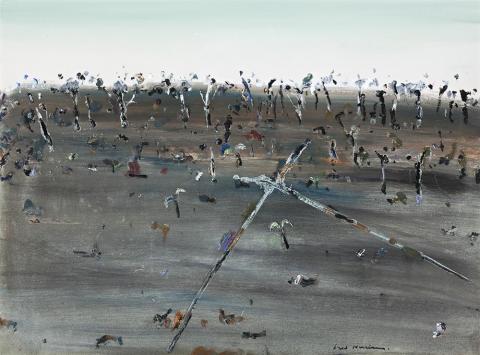ONE TREE HILL, FERNTREE GULLY, 1968
FRED WILLIAMS
gouache on paper
55.0 x 74.0 cm
signed lower right: Fred Williams
Probably Rudy Komon Gallery, Sydney
Private collection, Sydney
Company collection, Sydney
Mollison, J., A Singular Vision: The Art of Fred Williams, Australian National Gallery, Canberra, 1989, p. 137
One Tree Hill, 1968, oil on canvas, 101.5 x 112.0 cm, Private collection, Melbourne
One Tree Hill, 1968 – 69, oil on canvas, 122.0 x 153.0 cm, Private collection, Melbourne,
illus. in Mollison, J., A Singular Vision: The Art of Fred Williams, Australian National Gallery, Canberra, 1989, p. 136
We are grateful to Lyn Williams for her assistance with this catalogue entry.
Closely related to the first oil painting Fred Williams produced en plein air after a hiatus of almost ten years, also titled One Tree Hill, this gouache on paper is a careful investigation into the effects of bushfire on the Australian bush.1 The artist wrote in his dairy the day of this excursion: 'Down the track at the pond at F.T.G.N.P. (Fern Tree Gully National Park) find a very lovely spot I had previously made several gouaches here and we work all day in spite of drizzle. These are the first outdoor oils I have painted in many years! ... This has probably meant my closest look at a piece of country since the early days at Lilydale.'2 In the summer of 1967, the fires that ravaged the Dandenong Ranges nearly destroyed the artist’s home at Upwey. The traumatic yet inspiring experience led him to paint the very moving bushfire series including such works as Burnt Landscape, 1968 in the Gordon Darling collection.
In a distinctive composition featuring the recurring emblem of One Tree Hill’s crossed tracks in the Fern Tree Gully National Park, this painting is one of the most referential within Williams’ oeuvre. By reducing his stylistic devices to their most minimal expression, by the late 1960s Williams had developed an idiosyncratic shorthand that allowed him to explore variations of atmospheric effects, tonal and spatial intricacies within the natural landscape. Significantly, the visual cue of the landscape’s crossed tracks was also a mise en abyme (a self-reflexive embedding of an emblem within an artwork) of the artist’s own processes in the creation of his artworks. Speaking to James Gleeson in 1978, Williams explained his use of diagonal wires placed over his compositions to establish single or various focal points, a device used by pioneering classical landscape painters of the Barbizon school.3
Characterised by touches of paint and lines laden with black pigment set against a sweeping wash, One Tree Hill, Ferntree Gully, 1968 expresses Williams’ poignant appreciation of the distinctive scenery of Ferntree Gully National Park, and the destructive power of Australian bushfires. Shimmering and seemingly still smouldering, the delicate tones of this work evoke the overwhelming vastness of the artist’s vista, the line of trees bisecting the canvas reduced to slight apostrophes of paint on a pale horizon.
1. Ibid.
2. Williams's diary entry for 29 June 1968, as quoted in Mollison, ibid. p. 137.
3. Ibid., p. 100 – 101
LUCIE REEVES-SMITH
